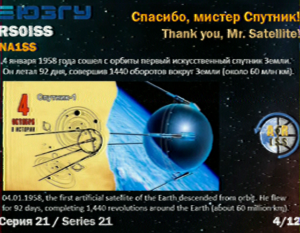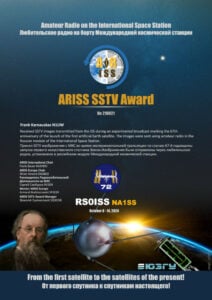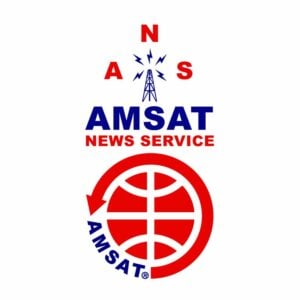
AMSAT News Service
ANS-315
November 10, 2024
In this edition:
- Celebrating AO-7: First Earth-Space-Space-Earth Relay Communications
- September/October 2024 Issue of The AMSAT Journal Available
- 2024 AMSAT Symposium Proceedings Available to AMSAT Members
- ASRTU-1 Satellite With FM Transponder Launched
- MO-122 Telemetry Beacon Level and Update – November 9, 2024
- ARISS SSTV Event
- Changes to AMSAT TLE Distribution for November 8, 2024
- ARISS News
- Upcoming Satellite Operations
- AMSAT Ambassador Activities
- Satellite Shorts From All Over
The AMSAT News Service bulletins are a free, weekly news and information service of AMSAT, The Radio Amateur Satellite Corporation. ANS publishes news related to Amateur Radio in Space including reports on the activities of a worldwide group of Amateur Radio operators who share an active interest in designing, building, launching and communicating through analog and digital Amateur Radio satellites.
The news feed on https://www.amsat.org publishes news of Amateur Radio in Space as soon as our volunteers can post it.
Please send any amateur satellite news or reports to: ans-editor [at] amsat.org
You can sign up for free e-mail delivery of the AMSAT News Service Bulletins via the ANS List; to join this list see: https://mailman.amsat.org/postorius/lists/ans.amsat.org/
Celebrating AO-7: First Earth-Space-Space-Earth Relay Communications
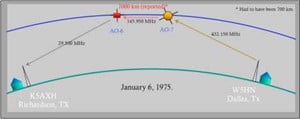
As AO-7, launched on November 15, 1974, approaches is 50th Anniversary and setting a record as the longest operating satellite, we look back at a few of its noteworthy accomplishments.
The downlink spectrum of AO-7’s UHF/VHF transponder overlapped with AO-6’s VHF-to-HF transponder. The overlap of the two was approximately 50 kHz wide. The two orbits were the same – almost. AO-7’s mean motion was slightly higher than that of AO-6, which means, once every year of so, AO-6 will “lap” its younger sibling in space. During the time when the two spacecraft are in closer proximity, it was already known to be theoretically possible (if AO-7 has its UHF/VHF transponder on) for one user to communicate through two spacecraft in succession, with the downlink of AO-7’s transponder being relayed through AO-6’s VHF/HF transponder uplink, and then, with the doubly relayed signal arriving on 29.5 MHz to another user on the ground. This could be done, in certain geometries, in both directions, making a two-way double-hop communications possible.
The first successful Earth-Space-Space-Earth relay of this type took place on January 6, 1975. This happened early in AO-7’s “first” lifetime and during the first occasion when AO-6 approached AO-7, in their very similar orbits. The two stations were both located in the state of Texas – one in Dallas and one in Richardson. This method of communications was also conducted and reported by 55 other user stations from 12 countries during 1975. These events were documented in the IEEE Proceedings in October of 1975.
See another AO-7 50 Year Anniversary highlight in next week’s ANS Weekly Bulletin.
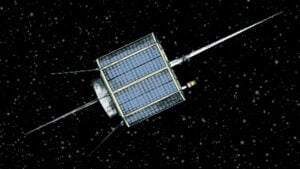
[ANS thanks Jan King, W3GEY, AMSAT AO-7 Project Manager for the above information]
September/October 2024 Issue of The AMSAT Journal Available
The September/October 2024 issue of The AMSAT Journal is now available to members on AMSAT’s Member Portal.
The AMSAT Journal is a bi-monthly digital magazine for amateur radio in space enthusiasts, published by the Radio Amateur Satellite Corporation (AMSAT). Each issue is your source for hardware and software projects, technical tips, STEM initiatives, operational activities, and news from around the world.
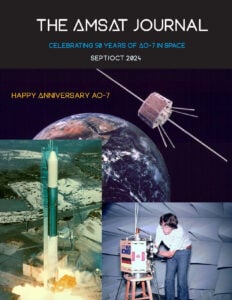
Inside the Current Issue:
- Apogee View – Robert Bankston, KE4AL
- AMSAT Awards – Bruce Paige, KK5DO
- The History of AMSAT AO-7 – Jan King, W3GEY
- Long Range Modulation (LoRa) in Low Earth Satellites – Omar Álvarez Cárdenas, XE1AO, et al.
- A Visit to the Tokyo Ham Fair 2024 – Keith Baker, KB1SF/VA3KSF
- 2024 Space Symposium and Annual General Meeting Photos
[ANS thanks AMSAT for the above information]
2024 AMSAT Symposium Proceedings Available to AMSAT Members
The Proceedings of the AMSAT 42nd Space Symposium and Annual Meeting are now available for AMSAT members on the AMSAT Member Portal.
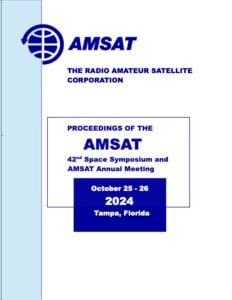
In this year’s edition:
- Welcome – Robert Bankston, KE4AL
- Silent Keys
- The AMSAT CubeSatSim v2.0 Software Overview – Alan Johnston, KU2Y
- AMSAT Education and CubeSat Simulator Project Update – Alan Johnston, KU2Y
- Integration of the AMSAT CubeSat Simulator for Education and Research – Rachel Jones, KO4HLC
- ARISS Prototype: Automation and Remote Control (ARC) of the IORS – Chris Thompson, G0KLA / AC2CZ / VE2TCP
- FUNcube Lite on Jovian-1, A 6U University CubeSat with an AMSAT-UK Payload – David Bowman G0MRF
- CARD-SAT® – A Step Forward for Satellite Miniaturization – Adrian Totu, YO3HOT
- GOLF-TEE Flight Software and Bus Overview – Burns Fisher, WB1FJ
- Determination of Spacecraft Orbital Elements from In-flight GNSS Measurement – Joseph DiVerdi, K0NMR
[ANS thanks Dan Schultz, N8FGV, AMSAT Symposium Proceedings Editor, for the above information]
2024 Coins Are Still Available!
Help Support GOLF and Fox Plus.
Join the AMSAT President’s Club today!
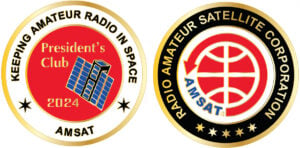
ASRTU-1 Satellite With FM Transponder Launched
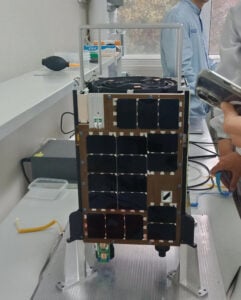
On November 4, 2024 at 23:18 UTC, a Soyuz rocket launched from Vostochny with at least 17 satellites using amateur satellite service frequencies. Among those launched was ASRTU-1, a 12U CubeSat designed by Russian and Chinese students and developed by the Harbin Institute of Technology in Harbin, China, for education and amateur radio.
The satellite contains an FM transponder, which is currently operational, with an uplink of 145.850 MHz (67 Hz CTCSS tone required) and a downlink of 435.400 MHz. After the repeater detects the end of uplink, it will wait for 0.5s. If no new uplink in 0.5s, telemetry will be sent. So make fast QSOs so the telemetry is less like to interrupt you.
The satellite also contains two cameras with an SSDV downlink for low resolution images on 436.210 MHz, and a high speed downlink on 10460.00 MHz for high resolution images.
On November 7, 2024, the camera system was tested for the first time. N6RFM uplinked the command and the image was downloaded by Chinese stations using the UHF SSDV downlink.
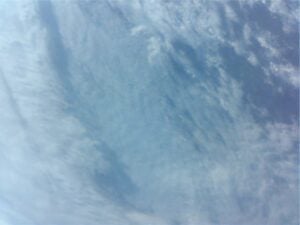
Windows software for decoding telemetry is available at https://drive.google.com/file/d/1W8nm-P0_h0J1Bd1eif74mLo-EuRdWcjH
A Live ISO Linux image is also available for telemetry at https://drive.google.com/drive/folders/1T6GMNnDNEEavckoe4oPXPIU_SPFXLDd4
A Telegram group has been created for discussing the satellite: https://t.me/+I5NTtX7eAJA4ZDVl
Latest TLEs:
ASRTU-1_20241108D
1 99130U 24313.98869213 .00036395 00000-0 15511-2 0 00005
2 99130 097.3830 178.7387 0016365 224.8894 196.6964 15.22873038000014
| ASRTU-1 | |||
| Uplink FM (67 Hz CTCSS) |
Downlink FM | Comments | |
| ASRTU-1 | 145.850 MHz | 435.400 MHz | In orbit, commissioning |
| Also downlinks on 436.210 MHz, 10460.00 MHz. Download Live CD for telemetry decoding. | |||
[ANS thanks BG2BHC, the IARU, and AMSAT-F for the above information]
MO-122 Telemetry Beacon Level and Update – November 9, 2024
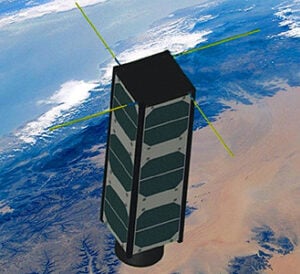
[ANS thanks Mark Hammond, N8MH, AMSAT Director and Command Station, for the above information]
ARISS SSTV Event Scheduled for November 11-18
Amateur Radio on the International Space Station (ARISS) announces an SSTV event to be held next week. The event is scheduled to begin on Monday, November 11 at 11:50 UTC and to end Monday, November 18 at 13:40 UTC. SSTV transmissions will be paused during scheduled school contacts on November 15 and 16. Downlink transmissions will be at 145.800 MHz and the mode is expected to be PD 120.
The transmissions will consist of 12 images featuring activities from the 2024 40th Anniversary Celebrating Amateur Radio in Human Spaceflight. If you are a past participant in our SSTV events, please note that we will be using our newly updated gallery at https://ariss-usa.org/ARISS_SSTV/ .
ARISS has a new way to request a special certificate. When participants successfully receive at least one image and submit it at the new gallery, participants will be moved to a thank-you page. There, a person can read text about data protection, and press the button that says “I agree,” and receive an email in two weeks or sooner with a certificate. If a person submits additional images, the thank-you page tells them they have already asked for a certificate.
Thanks to our user community for participating in ARISS.
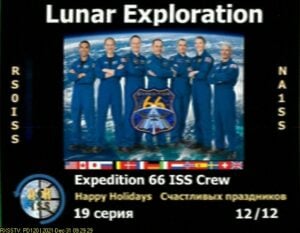
[ANS thanks Dave Jordan, AA4KN, ARISS PR, for the above information]
Changes to AMSAT TLE Distribution for November 8, 2024
Two Line Elements or TLEs, often referred to as Keplerian elements or keps in the amateur community, are the inputs to the SGP4 standard mathematical model of spacecraft orbits used by most amateur tracking programs. Weekly updates are completely adequate for most amateur satellites. TLE bulletin files are updated Thursday evenings around 2300 UTC, or more frequently if new high interest satellites are launched. More information may be found at https://www.amsat.org/keplerian-elements-resources/
SR-0 Demosat NORAD Cat ID 60455 Decayed from orbit on or about 02 November 2024
Binar 4 NORAD Cat ID 60952 Decayed from orbit on or about 04 November 2024
SO-121 NORAD Cat ID 58567 Decayed from orbit on or about 05 November 2024
Binar 3 NORAD Cat ID 60957 Decayed from orbit on or about 05 November 2024
[ANS thanks Joe Fitzgerald, KM1P, AMSAT Orbital Elements Manager, for the above information]
Need new satellite antennas?
Purchase an M2 LEO-Pack from the AMSAT Store!
When you purchase through AMSAT, a portion of the proceeds goes towards Keeping Amateur Radio in Space.

ARISS News
Amateurs and others around the world may listen in on contacts between amateurs operating in schools and allowing students to interact with astronauts and cosmonauts aboard the International Space Station. The downlink frequency on which to listen is 145.800 MHz worldwide.
International Aerospace School named after U.N. Sultanov, Ufa, Russia, direct via RZ9WWB
The ISS callsign is presently scheduled to be RSØISS
The ARISS mentor is RV3DR
Contact is go for Fri 2024-11-01 21:08 UTC
If anyone heard this contact, please let ARISS know.
Scuola Primaria “Bandello”, Castelnuovo Scrivia, Italy, telebridge via VK6MJ
The ISS callsign is presently scheduled to be NA1SS
The scheduled crewmember is Sunita Williams KD5PLB
The ARISS mentor is IZ2GOJ
Contact was successful: Thu 2024-11-07 07:56:25 UTC 25 deg
Congratulations to the Scuola Primaria “Bandello” students, Sunita, mentor IZ2GOJ, and telebridge VK6MJ!
Bishop O’Connell HS, Arlington, VA, telebridge via VK4ISS
The ISS callsign is presently scheduled to be NA1SS
The scheduled crewmember is Nick Hague
The ARISS mentor is AA6TB
Contact is go for: Fri 2024-11-15 18:06:21 UTC 46 deg
SWSU, Kursk, Russia, direct via TBD
The ISS callsign is presently scheduled to be RSØISS
The scheduled crewmember is Alex Gorbunov
The ARISS mentor is RV3DR
Contact is go for Fri 2024-11-15 19:15 UTC
Cottam Scouts, Cottam, ON, Canada, telebridge via IK1SLD
The ISS callsign is presently scheduled to be OR4ISS
The scheduled crewmember is Sunita Williams KD5PLB
The ARISS mentor is VE6JBJ
Contact is go for: Sat 2024-11-16 18:17:04 UTC 53 deg
Aznakaevsky district resp. Tatarstan, Russia, direct via TBD
The ISS callsign is presently scheduled to be RSØISS
The scheduled crewmember is Ivan Vagner
The ARISS mentor is RV3DR
Contact is go for Tue 2024-11-19 16:05 UTC
Center for the Development of Children and Youth Creativity in the City of Pugachev, Saratov Region, Russia, direct via TBD
The ISS callsign is presently scheduled to be RSØISS
The scheduled crewmember is Aleksey Ovchinin
The ARISS mentor is RV3DR
Contact is go for Wed 2024-11-20 15:15 UTC
Amur State University, Blagoveshchensk, Russia, direct via TBD
The ISS callsign is presently scheduled to be RSØISS
The scheduled crewmember is Alex Gorbunov
The ARISS mentor is RV3DR
Contact is go for Thu 2024-11-21 11:25 UTC
Many times a school may make a last minute decision to do a Livestream or run into a last minute glitch requiring a change of the URL but we at ARISS may not get the URL in time for publication. You can always check https://live.ariss.org/ to see if a school is Livestreaming.
As always, if there is an EVA, a docking, or an undocking; the ARISS radios are turned off as part of the safety protocol.
The crossband repeater continues to be active (145.990 MHz up {PL 67} & 437.800 MHz down), If any crewmember is so inclined, all they have to do is pick up the microphone, raise the volume up, and talk on the crossband repeater. So give a listen, you just never know.
Note, all times are approximate. It is recommended that you do your own orbital prediction or start listening about 10 minutes before the listed time.
The latest information on the operation mode can be found at https://www.ariss.org/current-status-of-iss-stations.html
The latest list of frequencies in use can be found at https://www.ariss.org/contact-the-iss.html
[ANS thanks Charlie Sufana, AJ9N, one of the ARISS operation team mentors for the above information]
Upcoming Satellite Operations
A growing number of satellite rovers are currently engaged in sharing their grid square activations on https://hams.at. By visiting the website, you gain easy access to comprehensive information about the operators responsible for activating specific grid squares. Additionally, you have the ability to assess the match score between yourself and a particular rover for a given pass, while also being able to identify the upcoming satellite passes that are accessible from your location.
Guyana: Aldir, PY1SAD (ZZ1M), operates from Georgetown as 8R1TM between Oct. 12 and Nov. 24 on 160-10m (CW, SSB, digital modes) and via satellites. QSL via LoTW, eQSL, qrz.com. (From DXNL 2427 – October 9, 2024)
[ANS thanks Ian Parsons, K5ZM, AMSAT Rover Page Manager, for the above information]
Want to fly the colors on your own grid expedition?
Get an AMSAT car flag and other neat stuff from our Zazzle store!
25% of the purchase price of each product goes towards Keeping Amateur Radio in Space
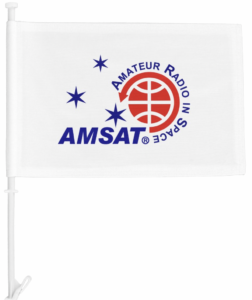
AMSAT Ambassador Activities
AMSAT Ambassadors provide presentations, demonstrate communicating through amateur satellites, and host information tables at club meetings, hamfests, conventions, maker faires, and other events.
AMSAT Ambassador Clint Bradford, K6LCS, says,
“Think a 75-minute presentation on “working the easy satellites” would be appropriate for your club or event? Let me know by emailing me at k6lcsclint (at) gmail (dot) com or calling me at 909-999-SATS (7287)!”
Clint has NEVER given the exact same show twice: EACH of the 150+ presentations so far has been customized/tailored to their audiences.
Scheduled Events
Yuma HAMCON
February 20-22, 2025
Yuma, AZ
N1UW
[ANS thanks Bo Lowrey, W4FCL, Director – AMSAT Ambassador Program, for the above information]
Satellite Shorts from All Over
+Hackaday featured a homebrew LNA suitable for satellite operation on November 4th. https://hackaday.com/2024/11/04/a-lesson-in-rf-design-thanks-to-this-homebrew-lna/ (Thanks to Hackaday for the informaiton)
+ AMSAT-EA released a statement on the decay of SO-121: “HADES-D (SO-121) satellite has re-entered the atmosphere, disintegrating as planned. Many thanks to the ham radio community for your support. We are glad that, even with its low power, many amateurs were able to make voice contacts and had fun receiving its telemetry.” (Thanks to AMSAT-EA for the information)
+ FO-29’s batteries are unable to support continuous operation of the analog transponder throughout its orbit after over 28 years. However, JARL continues to turn on the transponder at various times. Operation continues until the satellite’s UVC (under-voltage control) automatically turns off the transponder. Times for the remainder of November are:
Nov 10th 01:50 UTC
Nov 16th 01:35 UTC
Nov 17th 02:24 UTC
Nov 23rd 02:09 UTC
Nov 24th 01:15 UTC
Nov 30th 02:43 UTC
(Thanks to JARL for the information)
Join AMSAT today at https://launch.amsat.org/
In addition to regular membership, AMSAT offers membership to:
- Societies (a recognized group, clubs or organization).
- Primary and secondary school students are eligible for membership at one-half the standard yearly rate.
- Post-secondary school students enrolled in at least half time status shall be eligible for the student rate for a maximum of 6 post-secondary years in this status.
- Memberships are available for annual and lifetime terms.
Contact info [at] amsat.org for additional membership information.
73 and remember to help Keep Amateur Radio in Space!
This week’s ANS Editor,
Paul Stoetzer, N8HM
n8hm [at] arrl.net
ANS is a service of AMSAT, the Radio Amateur Satellite Corporation, 712 H Street NE, Suite 1653, Washington, DC 20002


